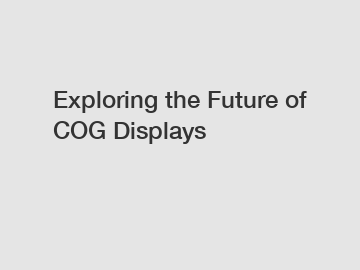Exploring the Future of COG Displays
Exploring the Future of COG Displays.
COG (Chip-on-Glass) displays are revolutionizing the way we interact with technology. These displays are designed to enhance the visual experience and provide a seamless interface for users. With their compact size, low power consumption, and high resolution, COG displays have gained significant popularity in various industries, including consumer electronics, automotive, and medical devices. In this article, we will delve into the future of COG displays, discussing their origins, the process of their development, and the significance and impact they hold.
The emergence of COG displays can be traced back to the increasing demand for compact and energy-efficient devices. As consumers began seeking smaller and more portable devices, the need for displays that could fit into tight spaces became evident. This led to the development of COG displays, where the display driver IC is directly mounted onto the glass substrate, eliminating the need for a separate PCB (Printed Circuit Board). By integrating the driver IC, COG displays achieve a thinner profile and reduced power consumption, making them ideal for modern electronics.

In terms of the technological process, COG displays involve a complex design and production workflow. The first step in creating a COG display is the design of the glass substrate, on which the display driver IC will be mounted. This design phase involves intricately positioning the traces and terminals to ensure proper connectivity. Once the design is finalized, it undergoes a fabrication process that involves multiple layers of thin-film deposition, photolithography, and etching to create the necessary circuitry.
The next stage involves mounting the driver IC onto the glass substrate using specialized equipment. This step requires precision and accuracy to ensure proper alignment of the IC's bond pads with the corresponding terminals on the substrate. Once the IC is mounted, it is wire bonded to establish the necessary electrical connections. Finally, the entire assembly is encapsulated with a protective layer to safeguard against damage and provide enhanced durability.
The evolution of COG displays has significant implications for various industries. In the consumer electronics sector, COG displays enable the development of sleek and compact devices, such as smartphones, smartwatches, and portable gaming consoles. The elimination of a separate PCB also reduces the overall cost of production, making devices more affordable for consumers.
In the automotive industry, COG displays have gained traction due to their ability to withstand extreme temperatures and vibrations. These displays are used in dashboard screens, navigation systems, and rear-view mirrors, providing drivers with crucial information in a clear and concise manner. Enhanced visibility and durability contribute to improved safety on the roads.
In the medical field, COG displays are utilized in vital monitoring equipment, such as patient monitors and ultrasound machines. Their high resolution and low power consumption make them essential for providing accurate and real-time data. Additionally, the compact size of COG displays allows for more portable and user-friendly medical devices, enhancing the overall patient experience.
In conclusion, the future of COG displays looks promising. Their compact size, low power consumption, and high resolution make them a desirable choice across various industries. As technology continues to advance, we can expect further innovations in COG display technology, leading to even more immersive and seamless user experiences. Whether it's in our pockets, cars, or healthcare facilities, COG displays are set to revolutionize the way we interact with information.
If you want to learn more, please visit our website custom vatn lcd, custom vatn lcd, Custom VATN LCD Display.
259
0
0

Comments
All Comments (0)